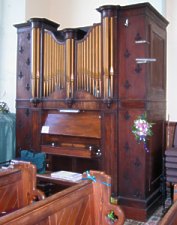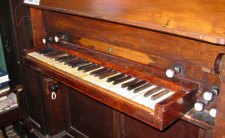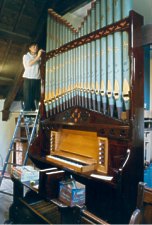Organs on the Isle of Man
So breathed the breath of his preluding,
And then the fugue began—
Organist in Heaven, T.E.Brown
The impetus behind this page was an 'organ crawl', a now annual event in which the IoM Organists Association arrange a
series of short recitals at various churches/chapels and the audience moves between sites thus experiencing some of the
various insular organs in a single day.
As of 2006 there are some 50 instruments on the Island, including five house organs, from a range of builders, some well-known
in the UK and others almost completely unknown off Island. Numerically the firms of Moses Morgan of Douglas ( workshop
at St. George's Walk) and later of Manchester, Henry Hewitt of Leicester and Peter Jones of St.John's are the most significant
but there are representative instruments of many other makers. Recently installed instruments include the Walker organ at
St.Anthony's, Onchan, and the Harrison and Harrison in St.George's, Douglas, and the very attractive portable
continuo organ by Peter Jones at the Erin Arts' Centre in Port Erin (he is also responsible for some four house organs).
I must, at this point, acknowledge the considerable help given by Peter Jones, based in St John's since 1979, who besides
constructing new instruments also maintains all the instruments on the Island and has renovated many.
Morgan's first instrument (Andreas Parish Church, 1898) was the first of about 12 instruments, the last being St.Catherine's
Church, Port Erin in 1912 - a remarkable record of more than one instrument per year. These organs were solidly made, with
an internal arrangement, mechanism and pipework which bear a strong family resemblance. There is some evidence to suggest
that some of the metal pipes were supplied by August Laukhuff of Weikersheim, Germany, a firm which continues today as the
largest of the organ supply houses to the trade.
H.W.Hewitt catered for the those churches requiring a cheaper instrument, and there are at least 9 of his organs which
are known on the Island. His usual practice was to obtain second-hand organs, and install them, usually with some modification
to make them more suitable for church use. His work was rough and ready, sometimes crude, but it has to be said that the
instruments that have survived were all working (after a fashion) and many of them have been renovated and improved to make
very acceptable, musical organs. The fact that they were made up from redundant parts, typically in the 1880s, means that
their pipework is often of considerable age, and interesting for that reason alone. Almost all the remaining instruments
are one-manual.
The following notes are approximately in date order of installation - in many cases the earlier instruments have been replaced
or considerably rebuilt. The Methodist Chapels also installed organs when money permitted and it may be that some of those
being replaced from the established church were transferred to chapels, though the story told of the period of introduction
(late 19th century) of a Primitive Methodist talking to a Wesleyan 'I hear you've got an organ in your chapel - all you
need now is a monkey!' To which the Wesleyan replied 'Yes, all you need is the organ!' - reflects the sometimes heated opposition
to their introduction by certain members, especially within Primitive Methodism.
St. George's Douglas
The first mention of an organ on the Island is associated with St George's,
Douglas - by the Act of Consecration of the said Chapel, dated 29 Sepr. 1781, the Lord Bishop reserved to himself and
his successors the right of nominating and collating a proper and sufficient Clerk or Chaplain, and also of appointing and
licensing an Organist for the said Chapel [see 1831 IoM Charities].
An organ was purchased soon afterwards funded by the rental of pews - Feltham
in his visit of 1797/8 describes it as 'handsome' - a report in the Manx Advertiser [26 May 1825] states
that
"preparatory to the Musical Festival the organ of St. George's has been sent off the Island for
repair. Its having been in the possession of Handel makes it more interesting than an ordinary instrument would be. It was
long considered well built."
The Musical Festival was reported 30 July 1825 which describes the newly returned organ thus:
It would be impossible to pass a detailed judgement on the quality of the organ, which we understand
had been built by Handel, from this first trial, Its pedal notes are true, and it possesses very considerable compass. The
organist under whose management the whole of the musical performances were conducted, exhibited great skill on the instrument
and uncomparable talent in the selection and management of all the services.
Unfortunately no further description has yet been found but it would appear that the organ was probably small in order
to be sent off the Island, it had some pedal notes and possibly a small console as otherwise it is difficult to see how
the organist conducted the performances (assuming by conducting the report meant musical conducting). Miss M.L. Wood, writing
of the 1860's however describes it as a 'wretched little organ, hidden away in a little
gallery near the roof'. Probably the pedal notes were added in 1825 as Grove's Dictionary of Music states that few British
Organs possessed them prior to 1790 though they were common in Germany. It is thought that this organ eventually found a
home in Sulby Methodist Chapel. The Handel connection might come via Fishamble Street Dublin but no definite documentary
evidence exists to give credence to the 1825 newspaper report. There is a 1933 article on the history
of St George's which quotes from letters dealing with the acquisition of this organ - the suggestion there is that it
may have been used during the rehersals for Messiah.
The idea that the previous organ had some connection with Handel has often been mentioned, but this is unlikely. The 1950s
Jardine incorporated parts of an older instrument, but the size of the soundboards and type mechanism have nothing to do
with the kind of organ which Handel would have known. It is just possible that one or two sets of pipes from a 'Handel'
organ might have been present amongst the rest, but Peter Jones, as the last organ builder to maintain the instrument, thought
this very doubtful.
A new organ was opened on 19th April 1865 within a newly built organ chamber part of the rebuilding of the old semicircular
apse to provide a new chancel, vestry and organ chamber
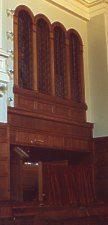 |
This instrument was replaced around 1950 by Jardine built to the requirements of the then organist, Dr.George Tootel,
who was well-known in his day as a cinema organist. Dr.Tootell was an accomplished musician with an F.R.C.O. earned
in his teens, a doctorate in music from Durham University; he was also a member of the performing rights society with
some 30 published compositions to his name (orchestral works, settings for choirs and pieces for organ); he was for
many years general secretary to the annual "Manx Guild". He was also a virtuoso organist and toured America
and the Continent in the later 1920s into the early 1930s opening Wurlizter, and Compton organs. He came back to the
Isle of Man to play at the Regal Cinema in 1935. For many years from the 1920s he was adviser on the building of organs
to the "Stoll" picture theatres (these were straight organs built by Jardine - there was also a Jardine
straight organ in the Strand Cinema in Strand Street in Douglas, where Tootell played) - an important feature in the
days of silent movies and was author of a book, "How to play the Cinema Organ" (published by Paxton.) However the
1950's organ, built to his own specifications by Jardine, together with the total lack of experience of the church's
architect of the day seemed to have produced an instrument which was truly remarkable for all the wrong reasons.
|
In 1865, the east end of the church had been remodelled, removing the old semicircular apse and providing a new chancel,
vestry and organ chamber. In April of that year, a new Jardine organ was opened which presumably occupied the whole of the
chamber, much as does the present Harrison organ. Doctor Tootel requested that this 'old' instrument be rebuilt into a comprehensive
3-manual organ with all the trimmings. The architect reduced the size of the organ chamber, cutting it in half with a concrete
floor at the level of the present gallery and providing a grille to for the sound to escape. Jardine's (who by then built
cinema organs as well as church organs, and were thus adept at squeezing much pipework and mechanism into a small space)
obliged. The result was a neatly packaged mountain of mechanism and pipework which was doomed as a musical instrument.
The 1950s Jardine had its console slotted neatly away under the concrete floor of the chamber, where the player could see
and hear very little. The builders provided a typical cinema organ console with the usual `horseshoe' shaped arrangement
of stop tabs, in a dignified stained oak finish complete with roll top. Behind the console was a largely empty room, which
became used, inevitably, as a junk store. It contained the enormous blower, and a most useful feature - a tiny door to the
outside of the church (which, though now sealed up, can still be seen from the outside.) This door was used by Dr Tootel
to make an unobtrusive exit from the church, before the last hymn on Sunday evenings leaving a pupil or sub-organist to
play the concluding music, so that he could fulfil his commitments at the Picture House Cinema in Strand Street (the facade
of which is still preserved above the modern shops.)
Above the concrete floor, behind the totally inadequate grille, the mechanism, manual and pedal pipes of the organ were
compressed into a tall, narrow, deep space with little opening into the church. The third manual (the Choir) and the Great
both spoke into the solid masonry wall which had originally been the east wall of the building. Around 3 feet thick, this
wall allowed no sound whatever into the church. The Swell pipework was housed in a room close to the present east end, from
which its sound emerged through the few swell shutters which could be accommodated into one end. The large pedal pipes were
buried on the back wall, behind everything else, and were little heard. Maintenance was difficult or impossible, due to
lack of space. Out in the church, the organ had a smooth, dark, sound, at its softest inaudible, at its loudest a muffled
roar. It is an unhappy truth that mistakes such as this have been made many times in the past, and continue to be made in
the present day, much of the blame often lying with the architect.
The pipework of the old organ, and parts of the console, were removed by Peter Jones just prior to the new organ's installation.
The concrete floor was taken out and the new instrument, which is much smaller than its predecessor, but has much more impact
in the building, now occupies all the space available, with a large opening for the sound behind its oak case. The polished
display pipes are of tin.
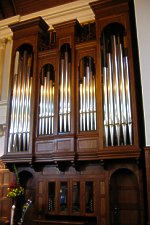 |
The present organ (2 manuals and pedals) was installed by Harrison and Harrison of Durham in 2003 and dedicated by
Bishop Graeme on Mothering Sunday 2004. It has a modern mechanical action to the manuals and pedals and direct electric
stop action and piston action. The usual layout in British organs is to position the pipes of the upper keyboard (the
Swell) on the same level as and behind the pipes of the Great (lower keyboard.) The design at St.George's is unusual,
but not unique, in having the Swell section of the instrument sited above the Great. This allows the builders to have
as much of the pipework as possible well forward in the case - a feature used to overcome the problem of a deep, narrow
chamber. (The same arrangement of Swell and Great may be found at St.Olave's, Ramsey and Trinity Methodist Church, Douglas.)
|
Ballure Chapel, Ramsey
A large barrel organ was installed in 1787
"the inferior clergy and the inhabitants of the parish of Ramsey entered into a subscription for
a large Psalmodic or Barrel-organ, to be erected in their Church, to perform all the tunes in Dr. Miller’s Selection
with additional interludes and voluntaries of his adoption "
History of Churches of South Ramsey
It is possible that this organ migrated to Santon.
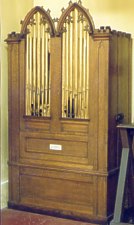 |
An example of a barrel organ now in Manx Museum - possibly the one from Ramsey + Santan |
St Mary's, Castletown
A petition was got up in 1806 for the purchase of an organ in the then insular capital
- to be funded out of the fine fund (i.e. money taken as fines in the law courts!).
In 1811 an organ was provided, Mr Philip Caley being appointed organist in 1815
— having played the organ for about three years. In 1823 he is described as
professor of music and organist at St. Mary's, a description is given by W.H.Gill.
The opening concert was -"A Grand Selection
of Sacred Music taken from the Sublime Oratorio of the Messiah, Redemption and
Creation, composed by Handel and Haydn to be performed." Tickets were to be
had from Mr. Gray, the Organist, for 5/- and at the shops of Messrs. Callow
Co. and Harrison. The Manks Advertiser in January 1812 describes the scene .
. . "On Tuesday the 31st ulto. at Castletown Chapel a grand Oratorio of Sacred
Music was performed for the benefit of Mr. Gray, the Organist, upon which occasion
nearly 'fifty guineas' were collected. It was numerously and most respectably
attended. Personages of the first rank and fashion honoured the occasion with
their presence, and were highly gratified. In short the whole performance could
not fail to afford universal satisfaction."
In 1899 the following advertisement was placed in the Isle of Man Times,
Saturday, 18th March 1899;
TO BE SOLD. ORGAN, now in St. Mary's Church, Castletown. Two manuals and
pedals The great organ contains eight stops Open diapason. 8ft, 56 pipes;
stopped diapason, 8ft. tone. 56 pipes: gamba. 8ft.. 56 pipes; dulciana, 8ft.,
44 pipes; principal, 4ft.. 56 pipes; flute. 4ft.. 44 pipes: fifteenth. 2ft..
56 pipes; mixture (2 ranks). 112 pipes. The swell organ contains four stops.
Gamba. 8ft.. 56 pipes: clarabella (with st. diap. bass, 8ft., 56 pipes; gemshora,
4ft., 55 pipes: flageolet. 2ft., 56 pipes; pedal. 16ft.. 25 pipes. Three couplers.
Swell to great, swell to pedals, great to pedals Five composition pedals,
three on great, two on swell. The case contains some show-pipes which could
be utilised for a new stop. To be sold cheap.Address. J. T. W. Wicksey. B.Mus..
Castletown, Isle of Man.
Wicksey was master at the Grammar School - the advert ran for just two issues
- but a couple of weeks too early for an April 1st edition.
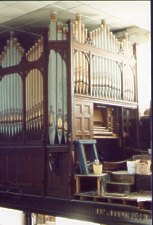 |
The organ installed in the south gallery during removal prior to conversion to office block.. The side rails to the
gallery had already been removed ! The double fronted case contains a considerable amount of display pipes (including
all those above the console) |
Braddan Parish Church
Braddan old church had no organ by 1832 as Hugh Stowell Brown commented
on the fact though one was loaned in 1837 by Mr Dale of Leece Lodge, this organ was bought (after money raised by sermons)
in 1839 for £20 4s. - this organ was damaged during a break-in in 1849 and apparently rebuilt in 1860. It was transferred
to the new church which opened 1876 where a new organ was installed in 1892. Gelling gives some of history of this - a meeting
had been called on 12 November 1891 to consider buying a new organ, the meeting decided to hold a bazaar which was held
at the Palace and which made a profit of some £751 of which no more than
£500 was to be spent on a new organ (the remainder, after all other expenses deducted, of £130 being spent on
the chancel). Accordingly Brindley & Foster built one which was first used on 21st May 1893. The old organ was moved
to St Luke's Baldwin where it remained until 1916, though the parishioners there could not raise the removal and re-assembly
cost and eventually most was paid by the organ committee.
Currently there is no organ in Old Kirk Braddan.
New Kirk Braddan
 |
As mentioned above the instrument at Old Kirk Braddan was moved into the new church but in 1892/3 it was replaced
by a new Brindley & Foster instrument
This was rebuilt in 1972 by Laycock & Bannister of Keighley. The action was changed to electro-pneumatic, a mixture
was added to the Swell, and the Great was provided with a new large open diapason, principal, twelfth and fifteenth.
A brief description is at <http://www.gumbley.net/organ.htm>
|
Roman Catholic Chapel, Douglas
A brief mention is found in the Manx Advertiser 4 June 1839
We are informed that on Sunday next the organ recently purchased for the Catholic
Chapel in this town will be 'opened' with a selection of works from Mozart etc. The service will
commence at the usual time half past 11 o'clock and every accommodation will be attended to strangers.
At this period the Catholics met in a converted theatre, stiled St Francis Xavier's, at the Prospect Hill end of Athol
street (St Mary's was opened in 1857) - the theatre eventually passed to the Methodist New Connexion before they built in
Derby square. The new St Mary's is described as having an organ loft
but the description does not include any of the organ.
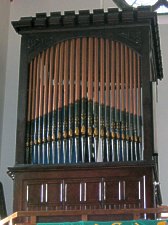 |
In Dean Walsh's Ireland and the Isle of Man is the final comment:
The last souvenir of Ireland transported to the Isle of Man was the organ that for so many
years served its exalted purpose in the Pro-Cathedral, Marlborough Street, Dublin. When a movement for a new organ
was set on foot, towards the close of the sixties, the old organ was advertised for sale, and the then Rector of Douglas,
Canon Kennedy, crossed over to Dublin, and speedily effecting a purchase, had it taken down and removed to Douglas,
where it was set up in the beautiful church built by Monsignor Carr.
Thus it would appear that the organ was installed c.1870.
The organ would appear to have been replaced, but keeping the original case, in 1913 with one from St Xavier's College
Liverpool as Peter Jones found a pencilled note inside during resoration work
|
St Barnabas', Douglas
A new organ was bought in 1842 and rebuilt in 1861 (opening concert by Mr F Gunton of Chester Cathedral).
Miss Wood describes it in the 1860's as ' a small two-manual organ, in a gallery over
the Communion Table, where also the choir sat' .
A new organ was bought for £500 in 1875 - Manx Sun for 23 April 1875 carries following:
New Organ for St Barnabas
A new organ has been ordered from the firm of Whiteley Brothers, Chester, for St Barnabas'
Church. The contract has been signed and the new instrument is expected to arrive about the latter end of June. It will
be placed at the south-east end of the church and the choir will be moved from their present position in the top west
gallery to the centre pews at the east end of the church. The new organ will have a case of pine wood, of ornamental design,
varnished and with decorated pipes in front. The west side will be enclosed similar to the front and be provided with
decorated pipes. The organ will cost about £500. The following is a copy of the specification:-
To have two complete manuals - compass of each CC to G 56 notes
Radiating pedals CCC to F 30 notes
| Great Organ |
| 1 Bourdon (prepared) |
16ft tone
|
| 2 Open Diapson |
8 ,,
|
| 3 Gamba |
8 ,,
|
| 4 Dulciana |
8 ,,
|
| 5 Stopped Diapason - bass |
8 ,,
|
| 6 Stopped Diapason - treble |
| 7 Flute Harmonic |
4 ,,
|
| 8 Principal |
4 ,,
|
| 9 Twelth |
2 2/3 ,,
|
| 10 Fifteenth |
2 ,,
|
| 11 Clarinett |
8 ,,
|
| 12 Mixture - 3 ranks-(Prepared) |
168 pipes
|
|
| Swell Organ |
| 13 Bourdon |
16 ft tone
|
| 14 Open Diapason |
8 ,,
|
| 15 Keraulophon |
8 ,,
|
| 16 Lieblich Gedact |
8 ,,
|
| 17 Gemshorn |
4 ,,
|
| 18 Fifteenth |
2 ,,
|
| 19 Cornopean |
8 ,,
|
| 20 Oboe |
8 ,,
|
| Pedal Organ |
| 21 Open Diapason 16ft |
30 pipes
|
| 22 Bourdon 16 ft tone |
30 pipes
|
| 23 Violoncello (prepared) |
30 pipes
|
|
Couplers - Swell to Great; Swell to Pedals; Great to Pedals.
Three composition pedals to Great Organ; two composition pedals to Swell Organ
[note prepared means not actually installed !]
The organ from the demolished St Barnabas was installed in Marown Parish Church in 1959.
Old St Matthew's, Douglas
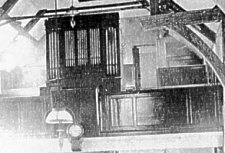 |
Manx Sun 12 Sept 1845 carries a brief comment that a new organ has been set up in St Matthew's Chapel, it
having been purchased by the congregation.
Photo shows organ in west end gallery - presumably moved to new St Matthews as there is another photo prior to demolition
showing an empty gallery.
|
St Matthew's, Douglas
A description of the 1922 organ in new St Matthew's, built by by Ernest
Wadsworth Limited, organ builders, Manchester, is available.
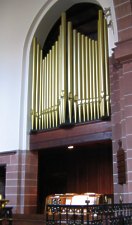 |
The existing Organ in St Matthews - the Wadsworth rebuilt by Wood of Huddersfield in 1979 with extensions in 1996
(Pedal trombone) & 1999 (8ft Oboe,4ft Clarion + 16ft Bourdon) done by Peter Jones.
The action is electro-pneumatic with a new detached drawstop console.
|
Malew Parish Church
Two reports in the Manx Sun for 9th & 16th March 1850 report on the new organ - the first [9 Mar 1850] stated
"a fine toned organ manufactured by Mr Minay of this town [Douglas], for the Parish Church of Malew will be opened
tomorrow".
The following week saw a more detailed report:
A Beautiful new organ was opened last Sunday. James Burman, esq., presided at the organ and he
accompanied the psalmody in an able and masterly style. This noble instrument contains 7 stops viz: open diapson throughout
- stop diapson - dulciano - principal - twelth - fifteenth - haut boy. The lofty and majestic tones of the organ, which
reverberated throughout the ancient building, were greatly admired by the crowded congregation. Mr Lewis Philip Garrett
of Douglas played the voluntary with great taste and judgement at both morning and evening services. The organ does great
credit to the ingenuous artist who manufactured it; as now that we have a talented builder residing amongst us it is probable
that organs will speedily adorn most of the churches and chapels throughout this diocese
D Minay is noted in a 1841 guide as an Organ Builder in Prospect Hill.
The organ was rebuilt and enlarged in 1897 (presumably by Hewitt) - it was also reported as being moved from the gallery
to the south side.
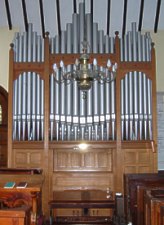 |
The present instrument dates from 1907 and was built by Moses Morgan of Douglas. It replaces the much smaller Hewitt
organ which was said to have been sited in the west gallery of the church, and was moved up to St.Mark's church at
this time.
The Morgan instrument is completely new, and typical of its builder, with 2 manuals (mechanical action) and pneumatic
pedals. The position of the organ is unusual and Morgan had to contend with a shallow site - a problem which he overcame
by the use of narrow scaled, wooden, basses to the Swell Diapason which made an unusually shallow swell box possible.
Lack of space also prevented the inclusion of the more usual Violone 16' as the second pedal stop, Morgan providing
an 8' Cello instead. The metal pipework is typical of this builder, and may have come from Laukhuffs, the trade suppliers
in Weikersheim. The attractive light oak case is reminiscent of those found at the Parish Churches of Andreas and
Laxey.
|
St John's National Church
|
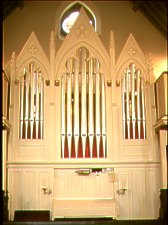
|
The organ was built by R. Jackson & Sons of Liverpool, at a cost of £150. It was opened on 7th March 1852
- originally in the west gallery, in 1907 it was moved, because of damp, to the north transept though since the gallery
has now been rebuilt it would be improved by being restored to that gallery (and have the side effect of not blocking
two of the fine stained glass windows.)
Described as a full-toned organ, of thirteen stops, with swell it was
completed some years after the consecration of the church. However in a
debate re the Tynwald ceremony of 1890 it was decribed by A W Moore as that "abominable hurdy-gurdy in the
organ loft".
|
St Thomas's Douglas
A lengthy report of the opening of the new organ in St Thomas's was carried by the Manx Sun 3 April 1852
We stated in our last that the organ recently manufactured for St. Thomas's Church had arrived
; it was erected so as to be used on Sunday last during the ordinary services, when it was presided over by Mr J. Wilkes,
R.A.. We have seldom heard an instrument which gave such unqualified satisfaction, and cannot but congratulate the indefatigable
Minister of St Thomas's district, and the Committee who have acted with him, upon the happy selection they have made in
appointing Messrs Forster and Andrews of Hull as the builders, on whose skill and judgement it reflects the highest possible
credit. These gentlemen were for some years pupils of the celebrated organ builder, Bishop, previous to 1841.
The organ is on the true German scale, having two full sets of keys, from C.C to G. in alto. In the list
of stops, which is given below, it will be seen that there are several quite new to the Island. We may remark about the
Diapasone (especially the open one on the great organ, which is on a very large scale,) are particularly effective, and,
assisted by the two Tenoromns, they produce a richness and full body of tone which is quite surprising. The Solo stops
too, are singularly sweet and delightful, especially the Viola di Gamba, Hautboy, and Clarabel ; the powerful trumpet-tone
of the Horn is very striking. There are likewise many modern improvements in the machinery of this organ. The Swell is
on a new principle for reflecting the sound, which has been successfully followed by the talented builders of this instrument
for the last two years. There are three combined Pedals (the clever invention of Bishop) which, by a slight pressure of
the foot, draw out and also take in the various stops in groups, thereby enabling the performer to produce many pleasing
effects. A very excellent and simple plan is adopted for keeping the machinery of the keys silent, and for reducing the
friction, thus rendering the touch much more flexible. The design of the case is strictly in keeping with the architecture
of the Church though as the instrument is placed in the tower on the north side of the building it can be seen by only
a very limited number of the congregation ; the propriety of this position is questioned by many, and certainly some effects
to be produced from the instrument are on this account interfered with; the Bourdon pipes especially do not give forth
that body of tone they are capable of producing were they heard from the western gallery. We understand that although
the congregation have come forward liberally with their contributions a large sum yet remains unpaid. Mr Reeves is appointed
organist, and we doubt not will soon obtain the assistance of an efficient choir.
The following is the list of stops in the great manual :- 1 Teneroon; 2 Bourjon ; 3 Viola di Gamba ;
4 Claribella ; 5 Stopt Diapason ; 6 Wald Flute ; 7 Principal ; 8 Sesquialtra ; 9 Fifteenth ; 10 Large open Diapason ;
on the swell manual, 11 Tenoroon ; 12 Open Diapason ; 13 Principal ; 14 Stopt Diapason ; 15 Fifteenth ; 16 Horn ; 17 Hautboy
; 18 Coupler Swell to Great Manual.
We learn that Messrs Forster and Andrews have entered into a contract to supply an organ for St Paul's
Church, Ramsey, which is to be completed during the summer.
Lewis Garrett was organist at one period, W.H.Gill gives a brief pen picture.
Manx Sun 10 Nov 1877 carries an interesting story of male chauvinism -
St Thomas's Church
We understand that Mr P.L. Garrett will tomorrow resume the post of Organist at St Thomas's
Church which post he resigned some weeks ago from ill-health. The office was then offered to Mr J.S.Mylrea who after a
few days consideration refused to accept it. The office was then offered to Miss
Wood who was then appointed organist; but the new incumbent making the point of having a male
Organist, Mr Garrett has been prevailed upon by him to return. We cannot pass over the singing last Sunday without remarking
on the great taste and feeling thrown into the hymns and must say that it is to Miss Woods infinite credit and shows her
proficiency as an organist and choir mistress to have effected so much in such a short space of time with comparatively
speaking a new choir.
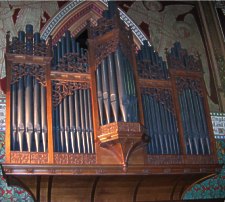 |
The 1852 organ was replaced in 1886 by a new organ with 1,682 pipes designed by Mr W.T. Best (organist at St George's
Hall, Liverpool, and a personal friend of Lewis Garett). It was built at a cost of £1000 by William Hill of London;
it had a hydraulic blowing mechanism. |
St Paul's Ramsey
|
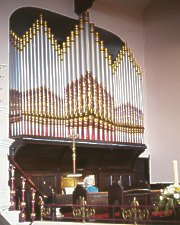
|
An Organ was put in by Foster and Andrews in 1852; this was replaced in 1883 also by Foster and Andrews, at the cost
of £540. Described as not one of the easiest to play with a heavy action but a quality instrument from one of
the leading builders of the day.
The old organ was apparently sold to Minorca Primitive Methodist Chapel Laxey for £45 (+ additional £36
to Mr Hewitt to install it) - it replaced an older organ at the chapel which required continual attention - it would
appear that it was broken up when the instrument from the closed Glen Road chapel was moved to Minorca.
|
Bishopscourt Chapel
A new organ costing £200, designed by Mr Jackson of Ballaugh, and described as the biggest on the Island was installed
in 1858
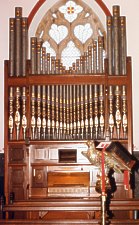 |
In 1878 a new organ was installed and the old one given to Kirk Michael parish church. |
Our Lady Star of the Sea, R.C. Church, Ramsey
The opening of the first church, in 1864, mentions an organist so probably a
small organ was installed - there is currently no organ.
Rushen Parish Church
An article in Manx Church Magazine of 1892 states that:
The organ, which, well maintains its excellence, was placed in the Church in November, 1864, during
the incumbency of the Rev Hugh Gill, It superseded a violincello, a flute, and a clarionet, on which instruments, as all
the older parishioners could testify, the late Messrs Thos. Qualtrough, James Turnbull, and Edward Kneen were wont to discourse
most excellent music, to the no small edification and content of the congregation
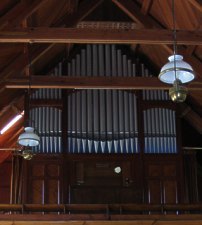 |
A newer and larger organ was installed in 1904 in the west gallery - this was by Moses Morgan and is the largest of
his organs installed on the Island.. |
Sulby Methodist Chapel
|
|
An organ was installed in Sulby Methodist Chapel in 1871 and transferred
to the new chapel in 1914. As mentioned under St George's this is thought to be the instrument installed in the 1780's.
A description provided by a local organist suggests that it is an 18th century chamber organ, originally dating from
c.1750, the top key having the date November 5th 1776 inscribed on the side. It has been modified in various ways
- in around 1880 by by the addition of a pedal board, pedal board stop, a swell box (now disconnected so as to give
greater volume) and swell stop.
|
|
Manuals: one - 54 keys on keyboard, 25 on pedal board
Stops:
Stopped Diapason (8ft)
Open Diapason (8ft)
Flute (4ft)
Principal (4ft)
Fifteenth (2ft)
Pedal Bourdon (16 ft)
Coupler stop: Pedal to keys
|
|
It has an attached console, all departments, except pedal stop, are in the swell box - the pipes are mostly original as
is probably the veneered casework with its dummy gilded front. Key and Stop actions are mechanical, with draw stops and
a straight keyboard.
In a reported lecture to Manx Methodist Historical Society Mrs F Bazin stated
that perhaps three instruments had been married.
Kirk Michael, Parish Church
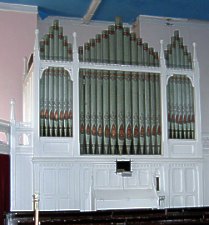 |
This is reported in 1927 as having been previously in use in St. Nicholas'
Chapel, Bishop's Court, which was being replaced by a new one and was presented by Bishop Hill in 1878. |
Ballaugh St Mary's
 |
A new organ with 9 stops and 312 pipes built by Foster and Andrews of Hull at a cost of £165 was opened on 7th
April 1878 (the opening was by Miss M L Woods organist of St Thomas's). Philip Teare of Ballaugh was appointed organist.
Single manual, mechanical action instrument; like its larger siblings at St.Paul's Ramsey and Trinity Methodist Church,
Douglas, the St.Mary's organ has a striking pipe display, in which even the wooden pedal pipes are painted like Easter
Eggs! All the metal (round) display pipes are dummies, as almost all the pipework is enclosed within a swell box.
Several of the stops are split into bass and treble sections, including the Bourdon, which, unusually from a modern
standpoint, is found on the manual keys (the pedals having no stop of their own, but acting merely as `pulldowns'
to the manual.) There is one 'prepared for' stop (i.e. a stop which the church intended to have, but which was never
installed). The builder, as is customary, has left space for the pipes within the instrument, and a blank stop head
on the console as a reminder.
|
Kirk Christ Lezayre
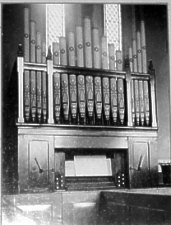 |
Edward Wadsworth, Salford 1874. used 1885 to 1926
Compass CC to F 54 notes; Pedal CCC to F 30 notes
|
Great Organ
Open Diapson 8ft
Stopped Diapson 8ft
Pinciple 8ft
Flute to Tenor C 4ft
Fifteenth 2ft
|
Swell
Spitzflute 8ft
Stop Diapson 8ft
Stop Diapson Bass 8ft 30 notes
Censhorn 4ft
|
Pedal
Bourdon 16ft 12 notes
|
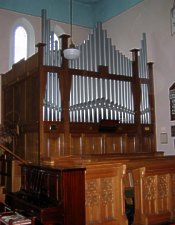 |
Current Organ is by Ernest Wadsworth |
St Catherine's, Port Erin
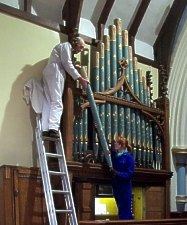 |
The instrument is by Morgan from about 1912
Photo, courtesy Peter Jones shows him and assistant fitting the last of the pipes after some repairs. |
St Mary's Port St Mary
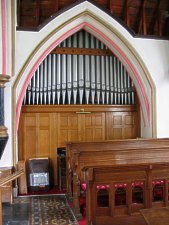 |
A report in Manx Church Magazine of Sept 1892 refers to the recent completion of the decoration by Mr Flaxney Stowell
and the completion of the organ by Mr Hewitt of Leicester. |
Jurby Parish Church
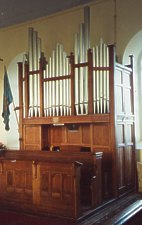 |
According to an information sheet in the church, the first organ at Jurby was installed in 1932 and was built by T.J.
Mullineux out of secondhand parts - this lasted some 32 years and was replaced by an electronic organ (by destroying
the pipe organ and inserting the electronic organ into the carcase) until the present organ was installed |
|

|
This Concher organ installed in the west gallery originally came from Peel
Christian Road Primitive Methodist Chapel, when this closed in the 1970's it was moved to Finch
Hill Congregational church (who had it rebuilt by the Irish Organ Company of Belfast), when this church too closed
(and later demolished) in the late 1990's it was moved to Jurby. The mechanism was converted to electric operation
on the move to Finch Road and thus it is one of the few Insular organs with a separate console.
|
Arbory Parish Church
|
|
A new organ was opened on 3rd July 1881 - in 1897 it was still hand-blown (by sexton).
Built by Hewitt (who supplied several churches on the Island around this time); he didn't actually build new organs
but tended to mix sections from older second hand organs thus it it likely that some parts date from some 50 years
earlier. However after a major renovation in 1996 it is now described as a solid and sensible design. Installed in
West Gallery
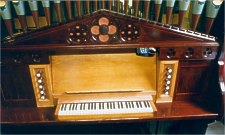
|
Bride Parish Church
 |
A new organ by Hewitt of Leicester at a cost of £65 replaced an earlier one (for which £15 'trade-in' allowance
was given). - it was opened on 3rd September 1882. |
St Paul's Foxdale
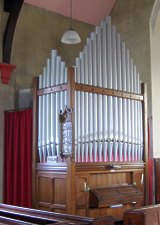 |
Another Hewitt instrument - very similar to Bride.

|
St Mark's
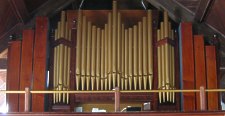 |
Hewitt - rebuilt by Peter Jones |
Maughold Parish Church
|
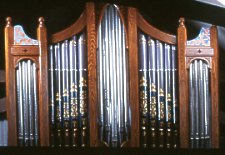
|
A new organ was opened 16th June 1878.
Current organ is a rebuilt Morgan & Pollard originally in Bay View Road Port St Mary Methodist (later Baptist)
church. The rebuild, by Island based Peter Jones involved considerable changes to allow it to fit into its some what
cramped new home - the case is mostly new though incorporating some of the original case. The console is now separate.
(see IoM Church Leader Jan 2001)
|
Crosby Methodist Chapel
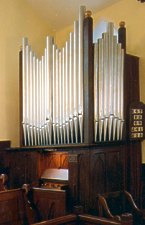 |
A second hand organ , probably by Forster and Andrews - this would appear to have been once at King William's college
as there is a considerable pencilled list of names of the hand blowers, including one recording a vist by W E Gladstone
(1878). Recently restored (and modified) by Peter Jones .

|
St Luke's, Baldwin
|
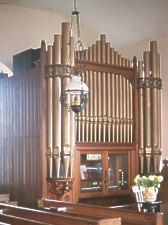
|
From the guide:
The large pipe organ came from Kentraugh
Mansion House, but had been vandalised and lay broken down for 46 years. In Millennium
Year 1979, we decided to repair the organ and Messrs Wood Brothers of Huddersfield, Organ,Builders, undertook the
work. It was necessary to purchase another organ from Hewsome Chapel, a Methodist Chapel in Huddersfield, before it
was demolished, in order to obtain the new woodwork and wooden pipes to match up with our metal pipes. We have a very
handsome instrument which is in use every Sunday one of the very few hand blown organs still is use in the British
Isles.
|
Since the guide was written electric power has reached this church and the organ now appears to be electric blown, though
the lighting is still oil!
Santon Parish Church
A mention of a 'barrel organ' is made by La Mothe -
The barrel organ in the church had a secular and a sacred barrel, the sacred barrel beginning
with the " Old Hundredth," and the secular one with the "College Hornpipe." Mr Geneste changed the barrels, and on one Sunday
morning, when the parson gave out the "Old Hundredth," he was astonished to hear the " Ta, ta, ta, ta, ta, ra, ra," of the
College Hornpipe. Great was the consternation of the parson and clerk at the supposed mishap. This was evidently an "organic"
defect!
A similar organ appeared to have been installed earlier in Ballure Chapel, Ramsey. No date was given but trick reportedly
played on Mr Gelling who was vicar 1835-1865. The barrel organ is now in the Manx Museum - it was made by Wrenshall of Liverpool
and is dated to late 18th Century (which corresponds to the date of installation in Ballure). It is described in B.D. Cotton
Manx Traditional Furniture Manx National Heritage 1993 pp248/9.
 |
A 'new' organ was installed in 1895 - this would appear to be an amalgam of several earlier
instruments. |
King William's College
 |
New organ provided for new chapel in
1868 and a further new organ in 1886 which in turn was replaced in 1897 by a new organ with 32 stops at a cost
of £600.
Since then replaced by another instrument.
|
Wesleyan Methodist, Waterloo Road Ramsey
Rosemount (Trinity) Methodist, Douglas
|
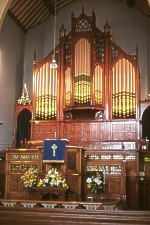
|
A splendid organ noted in a guide - The organ was opened by the famous W.H. Jude, in 1889
|
Thomas Street (later Victoria Street) Methodist Chapel
 |
An organ was added during the past year (Thwaites guide 1863) - however
by 1895 it drew the following comment in Methodist Recorder p34 1895(May) "Here I would ask, how is it
that the organ in Victoria street Church is allowed to remain in such a disgracefull condition? At the service above
referred to, the action of the blowing apparatus, &c was painfully audible at the other end of the church. ..
The organ, never a good one, has been repeatedly patched up, and now any more money spent on it will, I am credibly
informed, be practically thrown away".
The organ was in an east gallery above the pulpit. Photo dated c.1880 but suspect before the 1878 remodelling when
the chapel was re-aligned on the new Victoria street. It would appear that the instrument remained in the newly renovated
chapel.
|
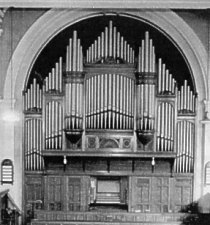 |
New Organ opened 19th Nov 1908 - this was the largest instrument built by Morgan. The church is now demolished. |
Well Road Chapel, Douglas
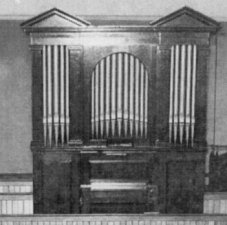 |
Well Road have recently had their little instrument rebuilt and added to Methodist Recorder p34 1895(May)
[the organ was re-opened May 1895] - the chapel is long since demolished.
Organ was in east end gallery above pulpit
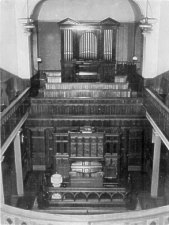
|
Wellington Street Primitive Methodist
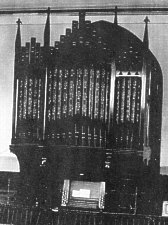 |
view c. 1880 - organ at east end behind pulpit.
Appears to be IIP with highly decorated pipework 12 stops on lh and 10 stops on rh.
Chapel closed in 1930's becoming part of brewery complex before demolition in the late 1980's to make way for the
new Marks and Spencer's store.
|
Buck's Road - Methodist Church (orig. Primitive Methodist)
This instrument was originally in the Wellington Street Chapel
but then transfered to the new Buck's Road Chapel when that opening
in 1900 - information kindly given by a grandson of a previous organist - instrument not built by Rushworth and Dreaper,
they were only involved with the maintenance and about 1956/7 did a renovation with a new swell box and an addition of 16
ft bourdon on the pedal.
|
Pedal.
16ft Diapason (open wood)
(Only one pedal stop.)
|
Great organ.
8 open diapason.
8 dulciana
8 clarabel
4 principal
4 flute
12th
15th
Mixture 3 ranks
8 Cremona
|
Swell organ.
( Nag's Head Swell Box. ie. lid that lifted up and down)
8 Diapason
8 Gedackt
8 Salicional
8 Vox Angelica
4 Gemshorn
8 Oboe
8 Horn
|
Super Octave
Swell to Great
Swell to Pedal
Great to Pedal |
St Peter's Peel
A new organ was installed in 1860; noted shortly afterwards as 'contains a good organ' (Thwaite's
guide 1863). The church is now demolished - it is not clear if it was transferred to the new church (now St German's
Cathedra)l.
Finch Hill Congregational
Manx Sun 15 Dec 1877 - Organ by Mssrs Foster & Anderson - recently erected opened by W. H. Jude. Replaced in
the late 1960's
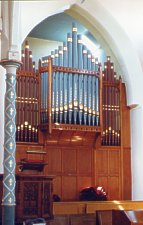 |
The electrified organ from Peel Christian Street as installed in Finch Hill United Reformed Church from the late 1960's
- the console is remote. After closure in 1993 moved and rebuilt at Jurby by Peter Jones. |
St Andrews, Presbyterian Church
An American Organ is noted as having been installed in the 1880's - these required
no musical training being mechanically powered by pedals and using toothed metal rollers to effect the tune.
Cathedral, Peel
|
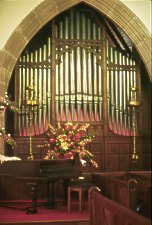
|
An organ was installed in time for the opening of the church in 1884 (not then either the Parish Church or the Cathedral).
|
St Stephen's Sulby
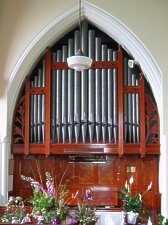 |
A new organ installed in 1899 - Morgan & Pollard IIP (altered by Rushworth) |
All Saints, Douglas
Jardine & Co. rebuild of a Morgan & Pollard organ - church is highly
reverberant - see Brochure
Peel Athol Street Methodist Church
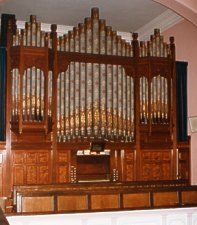 |
1892 Alex Young - in the gallery at the east end of the chapel |
Andreas Parish Church
 |
An organ had been installed by 1864 as it is reported to have been moved during the extensive alterations to the church
in 1864 (a subscription list had obviously been established as T. E. Brown
wrote back refusing to contribute unless the parishioners contributed). A new organ by Morgan
and Pollard (of Douglas) was opened on 24th November 1898 by Miss McKnight. It cost £250 as the entry in Morgan
& Pollard's account book indicates (now held in Manx Museum though this appears to be the only organ so suspect
the organ building accounts were separated from the piano tuning etc). |
Loch Parade - Methodist Church (orig. Primitive Methodist)
This instrument, probably the original from opening in 1878,
noted as by Hewitt, was broken up when the old church was rebuilt - information kindly given by a previous organist
|
Pedal.
16ft Diapason (open wood)
16ft Bourdon
16ft Echo Bourdon (from swell)
8ft Flute (from Bourdon)
8ft violincello
|
Great organ.
8 ft Open Diapason
8 ft Stopped Flute
8 ft Dulciana
8 ft Gamba
4 ft Harmonic Flute
4 ft Principal
2 ft Fifteenth
3 Rank Mixture
|
Swell organ.
16ft Lieblich Bourdon
8 ft Small Diapason
8 ft Lieblich Gedakt
8 ft Salcional
8 ft Voix Celeste
4 ft Gemshorn
8 ft Oboe
8 ft Cornopean
|
Superoctave
Swell to Great
Swell to Pedal
Great to Pedal. |
St Olave's Ramsey
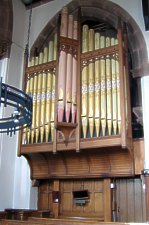 |
1896 (Morgan & Pollard) |
Christ Church - Laxey
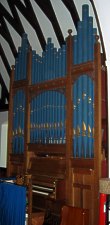 |
A Morgan instrument |
Kirk Michael Methodist Church
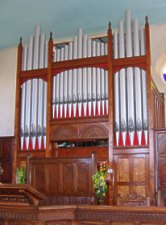 |
Morgan & Pollard. Restored 1993. |
Ballabeg Arbory (Wesleyan) Methodist Chapel
Isle of Man Examiner, Saturday, 31st December 1904:
To-morrow (Sunday) Special Services will be held in Ballabeg Wesleyan Chapel
in connection with the opening of the new organ. Several solos will be sung
at the evening service; and Mr H. Taylor, of Oldham, will preside at the organ.
Port Erin, Station Road Methodist Church
 |
1917 (M. Morgan & Co.)
Organ transferred here from Victoria Square Chapel
(now the Arts Centre which has recently installed a new chamber organ modelled on the 18th C model in Sulby Methodist
Chapel). |
Ramsey United Reform Church (formery Presbyterian)
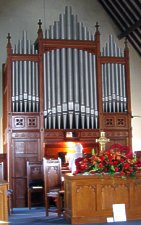 |
IIP by Alexander Young |
Minorca Methodist Chapel, Laxey
John Jolly recalls playing on this small 9 stop instrument in the early 50's - probably the 1852 Foster & Andrews from
Ramsey; chapel closed with services transferred to old Sunday School - organ broken up & replaced by the one from the
closed Glen Rd chapel
Laxey Methodist Chapel
 |
(J.J.Faulkner) 1906 - originally in Laxey Glen MC |
Castletown Methodist Church (formerly Wesleyan Methodist Chapel, Arbory St)
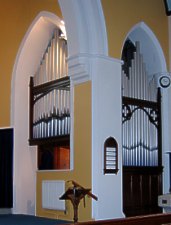 |
1912 Norman and Beard. |
Castletown Primitive Methodist Chapel, Malew St
Curry reported in 1907 that a new organ had recently been put in, costing £300, half of which has been borne by Mr.
A. Carnegie, the only gift he has made to the Island, secured by the energetic minister, the Rev. J. W. Lancaster. This
was the 1906 instrument by F. Pollard. The chapel was closed in the1960's and instrument was broken up and transferred in
large part to King William's College.
St Ninian's Douglas
A Norman & Beard instrument installed in 1915 'when the walls were dry'
Abbey Church, Ballasalla
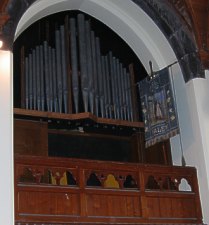 |
The present instrument was built by the Aeolian Organ Company, probably at their factory at Garwood, New Jersey,
U.S.A. The components are almost all of job no. 1162, a house organ for W.G.Watson of Sulhamstead House, near Reading,
Berkshire (ordered onAugust 27th., 1910 and shipped on January 24th., 1911.) Aeolian's British subsidiary was the
Orchestrelle Company, based in Hayes, Middlesex, and they would almost certainly have handled the order and installed
the instrument.
There is some confusion over the details of the Abbey Church organ, as the order book states that job 1162 had 9
ranks of pipes, whereas that in Ballasalla has only 8. Certainly, the instrument has been altered somewhat, and has
(unfortunately) had its console replaced with a conventional church organ detached console, very probably when it
was installed here by A.E.Davies (of Northampton) in the early 1950s. Davies replaced some of the pipework, presumably
to make the instrument more suitable for church use, and sited it in an architecturally convenient, but musically
unhelpful, 'chamber' in the tower. This chamber has an admittedly wide opening into the church, but Davies initially
sited the console within this opening, effectively reducing its area by about 50%. Matters were made worse by the
fact that they fitted an inadequate number of swell shutters, through which the sound has to emerge. The console was
later moved downstairs to a position much more convenient for (and less dangerous to) the organist. The front pipe
display is made up entirely of dummies.
|
In 2005/6 the Aeolian was completely dismantled and renovated by Peter Jones, when its remarkable mechanism (partly electric,
partly pneumatic) could be appreciated. The majority of the instruments designed by this company were destined for the homes
of the wealthy and a special feature of the Aeolian organs of this date was that the console contained an automatic playing
action, which worked in a similar way to that of a player piano. Its smooth, orchestral sounds may no longer be in favour
with the professional organist, as fashions continue to alter, but it continues to give reliable and faithful service
All Saints Lonan
|
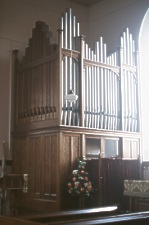
|
1936 (Albert Keates)
|
St Runius (Marown Parish Church)
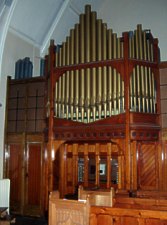 |
1959 (Alfred E.Davis & Son Ltd.) |
Douglas - Christian Science Church
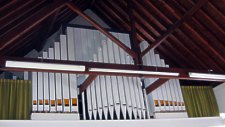 |
various makers |
St Peter's Onchan
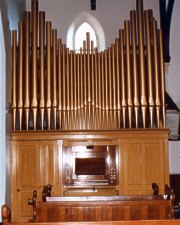 |
Brindley & Foster, rebuilt Peter Jones |
St Anthony's RC Church, Onchan
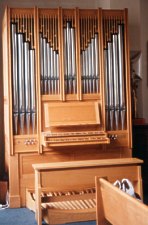 |
J W Walker 'Studio' installed 1990 |
St Peter's Cregneish
The arrival of the Aeolian at Ballasalla displaced a Victorian (or earlier) chamber organ which was moved by Francis Kitts
(an organ builder then at work on the Island) to St.Peter's, Cregneish. Unfortunately, this was removed and sold it off-island
so that this church now has no pipe organ.
Ballasalla Methodist Church
Both church and organ are no more. The organ was a 2-manual, mechanical action
instrument by Morgan. It had an impressive display of front pipes, and these, and the rest of the manual pipework, were
salvaged by Peter Jones and re-used in one of his house organs; the blower eventually found its way into the rebuilt organ
at Maughold Parish Church and the pedals in the renovated instrument at St.Mark's Church.
Nunnery Chapel
This was a private Anglo-catholic chapel - a small one manual instrument
of uncertain origin was installed in the west gallery
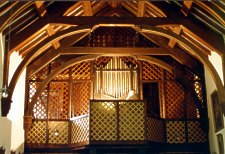
west gallery in Nunnery Chapel (c. 1985) |
zz 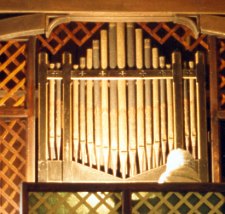
Pipework of organ in Nunnery Chapel |
Cinema Organs
Regal Cinema, Victoria Street, Douglas
Described as an undistinguished building erected on site of the Grand Theatre
- opened in June 1935 with a Compton Unit organ with the first Mellotone attachment to be fitted in the British Isles. The
organ was removed by mid 60's and the cinema closed - was put back on maintenance by the then owners the Palace & Derby
Castle Co. sometime time before this when they were trying to revive the cinema's fortunes.
Picture House, Strand Street, Douglas
Noted as one of the few examples of Manx pseudo half-timbering - it also had a Compton organ - cinema closed many years
years ago.
Port Erin Arts Centre
 |
Chamber organ at Port Erin Arts Centre - designed and built by Peter Jones. The photograph shows the two doors fully
open for maximum volume - when closed atractive painted figures are visible on the other faces. |
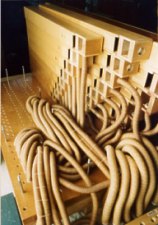 |
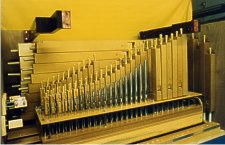
Two views of the internal mechanism - the 'wood' is actually MDF! |
Private Instruments
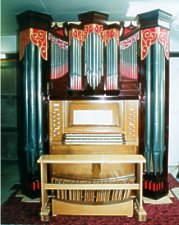 |
Some details of the casework, pedal and other pipes came from the instrument at St Mary's Castletown, the flute rank
from St Andrews URC Douglas, designed by Peter Jones. |
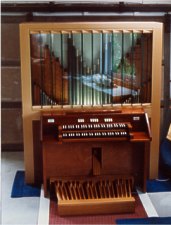 |
The glass panels are the swell shutters - another Peter Jones designed and built instrument |
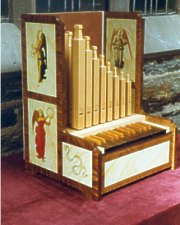 |
A portative organ, designed to be carried in procession and played with one hand whilst the other operates the bellows
at the 'back'. The angel designs are prototypes for the Port Erin chamber organ - another Peter Jones instrument. |
Harmoniums and American (Reed) Organs
These use the passage of air over a tuned metal reed coupled to a sound board to produce the sound, both use pedal operated
bellows to move the air - the Harmonium is a French invention dating from around the 1840's and uses air blown through the
reed as in a pipe organ, an American Organ uses the bellows to produce a partial vacuum which sucks air through the reed.
Reed Organs were very popular from about the 1880's and were mass produced in tens of thousands, mostly in Canada. Most
small Methodist chapels would use one, as well as many private homes - there are still such instruments for example in Ballaugh
Old St Mary's (now with electric 'blower'). Unfortuneately the ravages of time, changed tastes and the destructive woodworm
have led to the loss of most on the Island though many still remain.
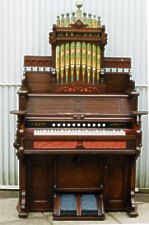
A somewhat ornate model - the pipes are purely decorative dummies - in private hands on the Island. |
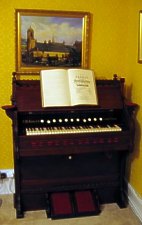
The editor's own instrument - built in 1887 in Canada and belonged from new to a well known Manx family - now restored. |
Updated list based on National Register
This list is based on the now considerably out of date National Pipe Organ Register - I have amended the address/title
of a few buildings as those in the register are somewhat strange.
Several of the instruments would appear to have been needlessly destroyed - in some cases the church has used a number
of unsuitable electronic organs whereas if the money had been spent on refurbishing the pipe organ it would probably have
lasted another century.
|
| NPRO |
Address |
Building |
Manuals |
Details |
| N02030 |
Rushen |
Kirk Christ |
IIP |
1904 (Morgan) |
| N02031 |
Port Erin |
St.Catherine, |
IIP |
1912 (Morgan) |
| N02032 |
Port St.Mary |
St.Mary, |
IIP |
(Unknown) probably Hewitt |
| N02033 |
Cregneish |
St.Peter, |
I |
(Forster & Andrews) removed off Island |
| N02034 |
Port Erin |
Station Road Methodist, |
IIP |
(A. W.Hewitt) Replaced by N02035 |
| N02035 |
Port Erin |
Victoria Sq Methodist Church, |
IIP |
1917 (M. Morgan & Co.) - building now Erin Arts Centre, instrument transferred |
| N02036 |
Port St. Mary |
Bay View Methodist Church, |
IIP |
1899 (Morgan & Pollard), building demolished, instrument transferred to Maughold |
| N02037 |
Castletown |
St Mary's, |
IIIP |
(Albert Keates) building deconsecrated, instrument broken up |
| N02038 |
Ramsey |
Parliament Street Methodist, |
I P |
(Unknown) building demolished, broken up |
| N02039 |
Arbory |
St. Columba, |
IP |
1885 (H.W.Hewitt) since rebuilt by Peter Jones |
| N02058 |
Peel |
St.German, [Cathedral] |
IIIP |
1883 (Brindley & Foster) rebuilt IIP by Laycock & Bannister |
| N02059 |
Bishop's Court |
Chapel of St.Nicholas, |
IP |
chapel now within private residence (Bevington) |
| N02060 |
Malew |
St. Lua, |
IIP |
1907 (M.Morgan) |
| N02061 |
Ballasalla |
Ballasalla Methodist Church, |
IIP |
(Unknown) Morgan, building demolished, now broken up |
| N02062 |
Castletown |
Arbory Street Methodist Church, |
IIP |
1912 (Norman & Beard) building no longer chapel |
| N02542 |
Douglas |
Loch Parade Methodist Church, . |
IIP |
(H.W.Hewitt) broken up when new church built. new church has gone through 3 electronic organs |
| N02543 |
Douglas |
St. Andrew, |
IIP |
(H.W.Hewitt) broken up when church demolished, new church has electronic |
| N02544 |
Douglas |
St.Mary RC, |
IIP |
(Gray & Davison) |
| N02545 |
Douglas |
Victoria Street Methodist Church, |
IIIP |
1908 (M.Morgan) building demolished, broken up |
| N02546 |
Douglas |
St. Matthew, |
IIP |
(Ernest Wadsworth) much rebuilt and altered by Woods of Huddersfield & Peter Jones |
| N02547 |
Douglas |
St.Thomas, |
IIIP |
1913 (W.Hill & Son) |
| N02548 |
Douglas |
Buck's Road Methodist Church, |
IIP |
(Rushworth & Dreaper) building demolished, broken up |
| N02549 |
Douglas |
St. George, |
IIIP |
1952 (Jardine & Co.) replaced 2003 |
| N02550 |
Douglas |
St. Ninian, |
IIP |
1915 (Norman & Beard) |
| N02551 |
Douglas |
Rosemount Methodist Church, |
IIP |
1889 (Forster & Andrews) |
| N02552 |
Douglas |
Broadway Baptist Church, |
IIP |
1933 (Albert Keates) broken up as late as 1994 |
| N02553 |
Peel |
[Atholl st] Methodist Church, |
IIP |
1892 (Alex Young) |
| N02554 |
St. John's |
Royal Chapel of St.John the Baptist, |
IIP |
1907 (M.Morgan) |
| N02555 |
St. John's |
Methodist Church. |
IP |
(Forster & Andrews) destroyed |
| N02556 |
St. Mark's |
St. Mark, |
IP |
(H.W.Hewitt) rebuilt Peter Jones |
| N02557 |
Crosby |
Methodist Church |
IP |
(Forster & Andrews) ex KWC pre Wadsworth |
| N02558 |
Marown |
St Runius |
IIP |
1959 (Alfred E.Davis & Son Ltd.) |
| N02559 |
Braddan |
Braddan new |
IIP |
(Brindley & Foster) |
| N02560 |
Lonan |
All Saints, |
IIP |
1936 (Albert Keates) |
| N02561 |
Laxey |
Christ Church, |
IIP |
(M.Morgan) |
| N02562 |
Laxey |
Glen Road Methodist Chapel, |
IP |
(J.J.Faulkner) 1906 chapel closed & instrument transferred to new Minorca |
| N02563 |
Laxey |
Minorca Methodist Church, |
IIP |
(Unknown) ?probably 1852 Foster & Andrews from Ramsey; chapel closed, church transferred to old Sunday School;
broken up & replaced by N02562 from closed Glen Rd chapel |
| N02564 |
Maughold |
St.Maughold, |
IIP |
1965 (Hill, Norman & Beard)taken down (currently in store) replaced by rebuild of Port St Mary |
| N02565 |
Kirk Michael |
St.Michael, |
IIP |
(Samuel Renn) |
| N02566 |
Kirk Michael |
Ebenezer Methodist Church, |
IIP |
(Morgan & Pollard) |
| N02567 |
Ballaugh |
St.Mary de Ballaugh,[Ballaugh New] |
IP |
1878 (Forster & Andrews) |
| N02568 |
Lezayre |
Kirk Christ Holy Trinity, |
IIP |
(Ernest Wadsworth) |
| N02569 |
Ramsey |
Waterloo Road Methodist Church, |
IIP |
(J.Hepworth) Replaced by Laycock & Bannister IIP |
| N02570 |
Ramsey |
Trinity Presbyterian Church |
IIP |
(unknown)Alexander Young |
| N02571 |
Ramsey |
St.Paul, |
IIP |
1883 (Forster & Andrews) |
| N02572 |
Ramsey |
St.Olave, |
IIP |
1896 (Morgan & Pollard) |
| N02573 |
Jurby |
St.Patrick, |
IIP |
1932 (T.J.Mullineux) destroyed in 1974;replaced 1994 by instrument from Finch Hill |
| N02574 |
Andreas |
St.Andrew, |
IIP |
1898 (Morgan & Pollard) |
| N02575 |
Bride |
St.Bridget, |
IP |
1875 (H.W.Hewitt) |
| N02576 |
Bride |
Methodist Church, |
IIP |
c.1874 (Unknown) ?Hewitt c 1880 |
| N02577 |
Onchan |
St.Peter, |
IIP |
(Brindley & Foster) rebuilt Peter Jones |
| N02578 |
Kirk Santan |
St.Sanctain, |
IIP |
(Hewitt) |
| N02579A |
Ballasalla |
Abbey Church of St.Mary, |
IIP |
1950 (Alfred E.Davis & Son Ltd.) |
| N02580 |
Port St. Mary |
Mount Tabor Methodist Church, |
IIP |
(William Andrews) |
| N02581 |
Foxdale |
St.Paul, |
IP |
(H.W.Hewitt) |
| N02582 |
Castletown |
St.Thomas' Chapel, King William College, |
IIIP |
(Wadsworth & Brother) broken up; current instrument IIP rebuild of N02863 |
| N02863 |
Castletown |
Malew Street Methodist Church,, |
IIP |
1906 (F Pollard) broken up & transferred in large part to KWC |
| Additional Instruments (private house organs not included) |
|
Sulby |
Methodist Church |
IP |
before 1800;converted from a chamber organ |
|
Sulby |
St Stephen's |
IIP |
Morgan & Pollard (altered by Rushworth) |
|
Baldwin |
St Lukes |
IIP |
Concher |
|
Croit-e-caley |
Methodist Chapel |
IP |
unknown - probably Hewitt |
|
Douglas |
All Saints PC |
IIP |
1967 Jardine (rebuild of earlier Morgan & Pollard) |
|
Douglas |
Nunnery Chapel |
IP |
? |
|
Douglas |
|
IIIP |
Wurlitzer (?1922 though apparently significantly altered over its life) - one time in Summerland, now in store; according
to a news report it was originally at a Leicester cinema, then in the hands of a private buyer before being bought by
IoM Government in 1989 - it appears, after much heated debate, to be destined for a 100 seater space in the refurbished
Villa Marina arcade. |
|
Douglas |
Christian Science Church |
IIP |
various |
| |
Onchan |
St Anthony's RC |
IIP |
1990 J W Walker 'Studio' |
|
St Marks |
Ballagarey St Marks MC |
IIP |
1935 John Compton (installed 2006) |
References
J. Gelling A History of the Manx Church Douglas:Manx National Heritage 1998 gives some history of the installation
of organs in the churches though no description of the instruments themselves.
National Pipe Organ Register - cover UK and Manx organs though
some of entries are somewhat out of date as based on a survey 1958-1963 since when many Methodist chapels have been closed
and their instruments moved.
Many of the Photographs courtesy of Peter Jones, who can be contacted via the
editor for more details the organs.
J Kewley Churches of Mann Lily Publications 2009 ISBN 978-1-899602-82-7
appeared some years after this page originally appeared has, besides many stunning
photos of the Island's Churches and Chapels, a brief coverage of their organs
with an accompanying CD of their sounds.
|
|

|
|
|
|
|
Any comments, errors or omissions gratefully received The
Editor
© F.Coakley , 2002
|














